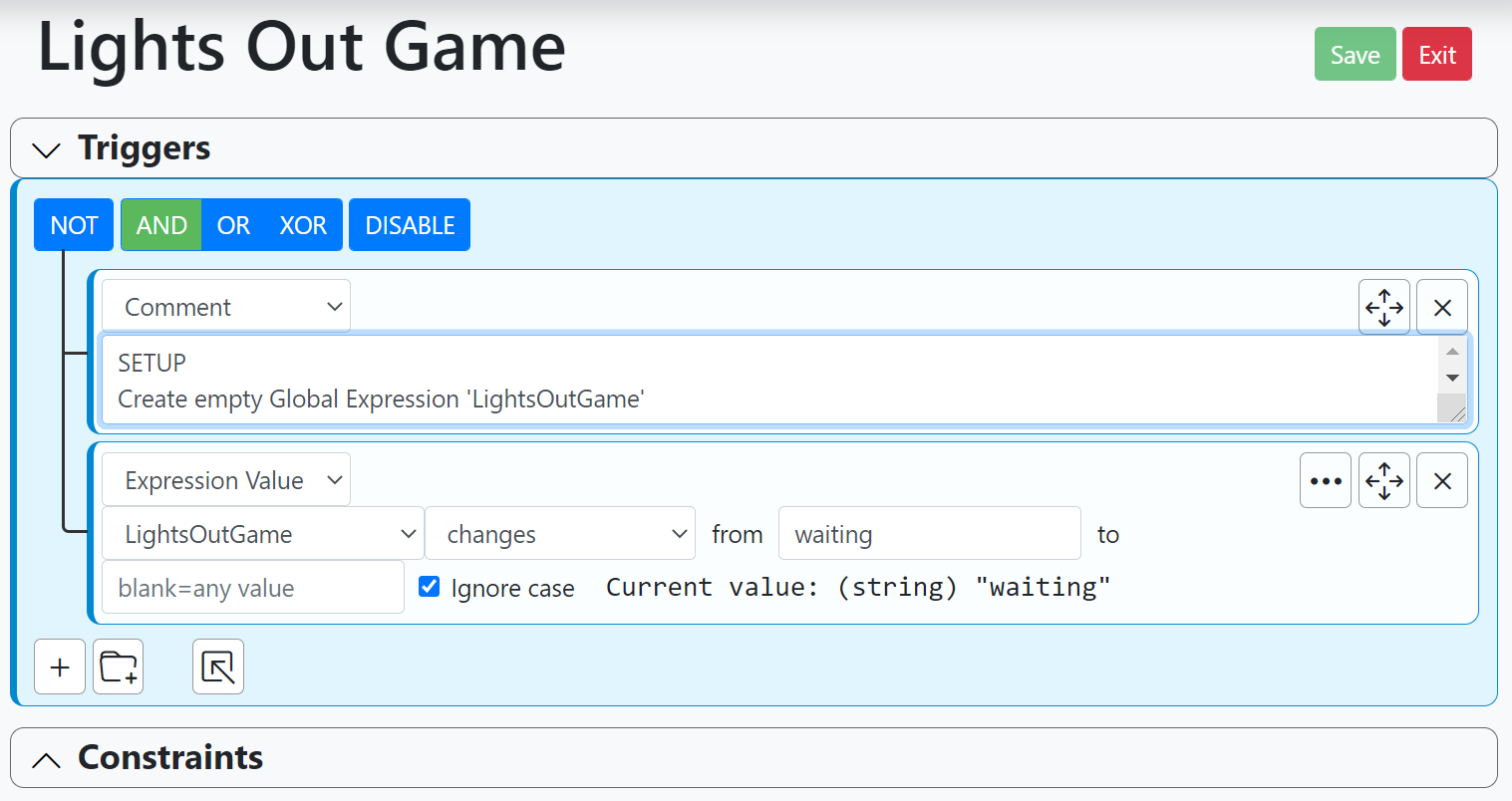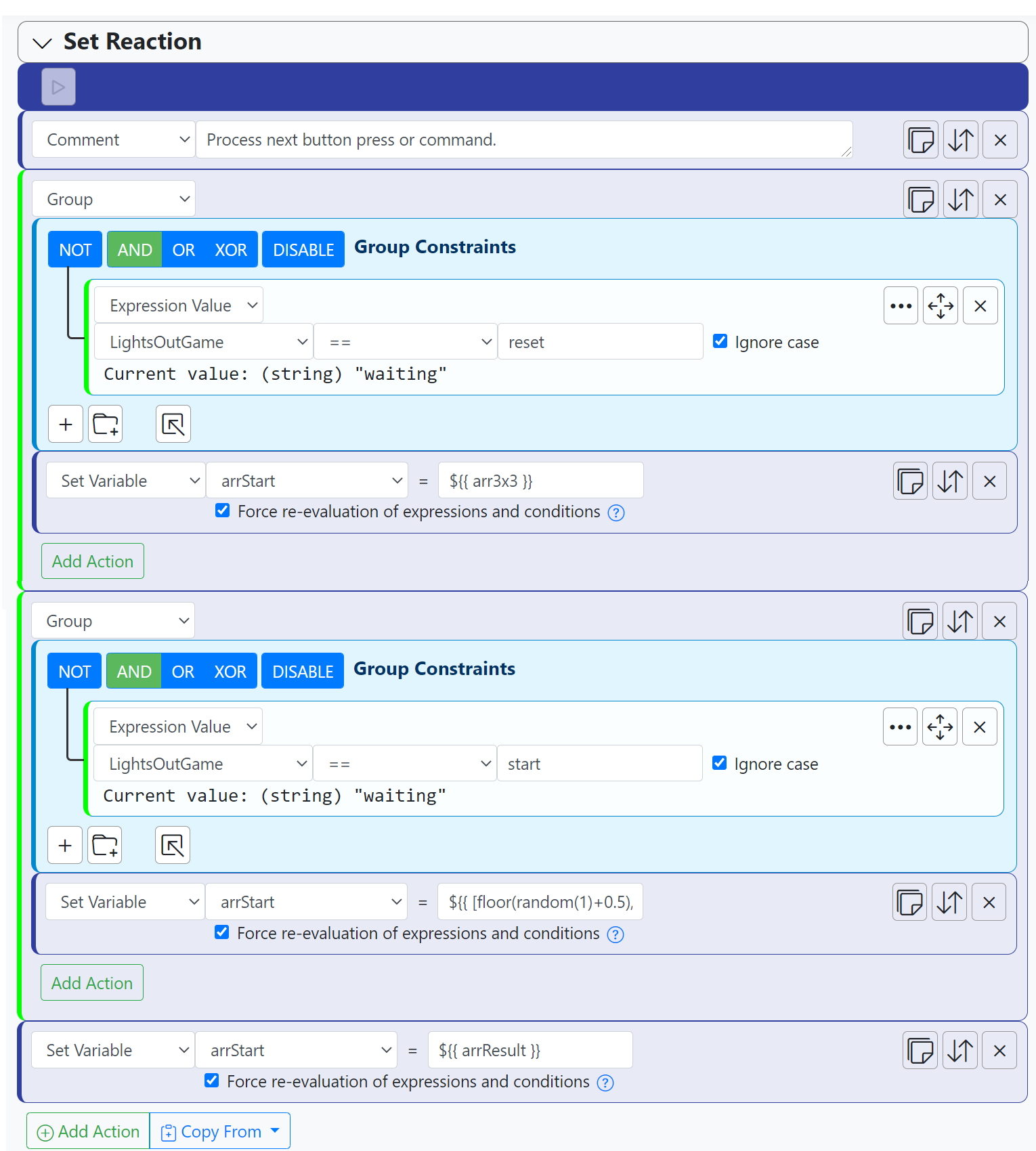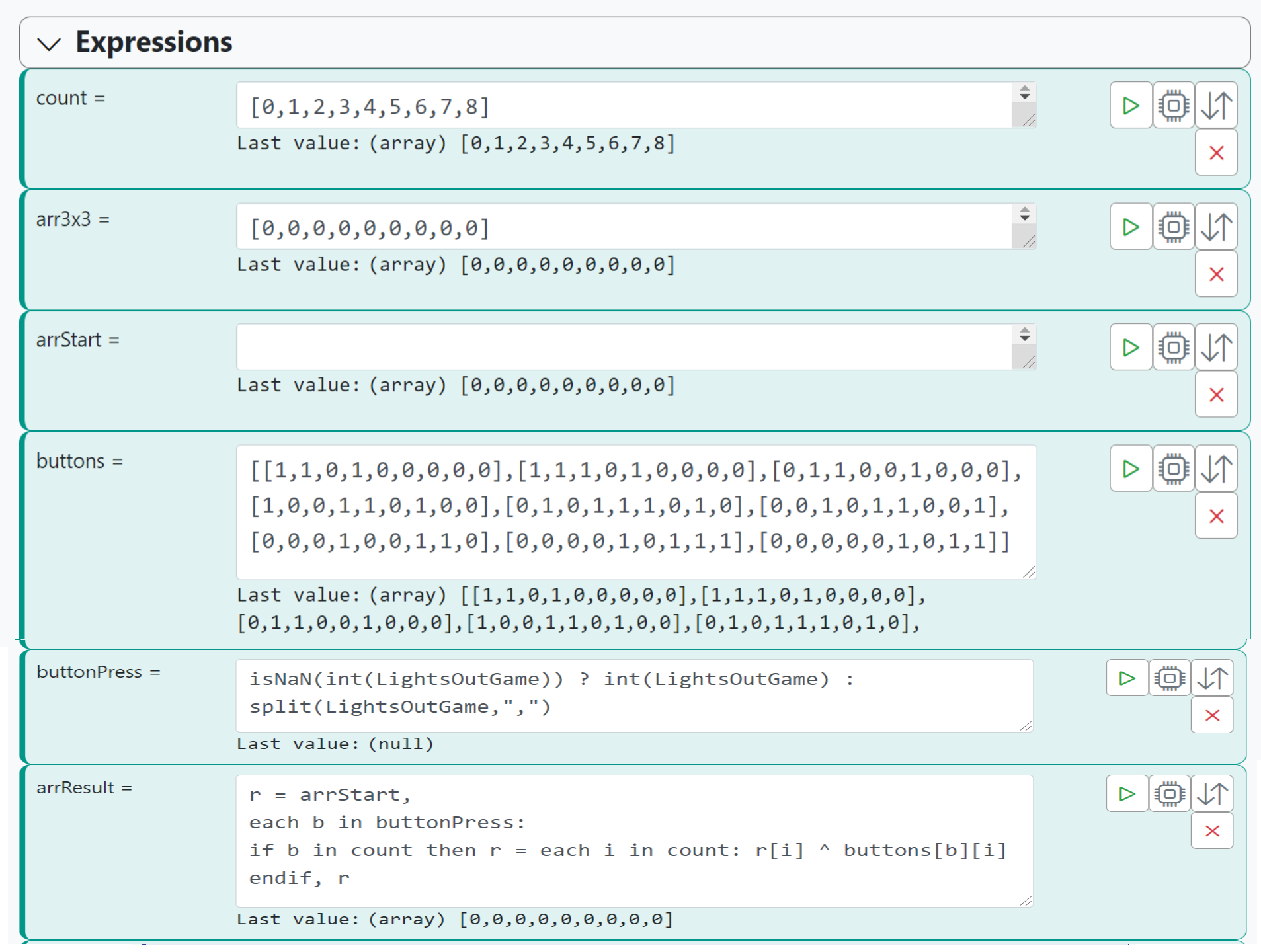I've managed to use MSR UI on iOS devices to some degree*, so that although UI elements (e.g. rule sets) are not visible in portrait mode, you've seen them in landscape. Now with recents builds (24302) this does not work anymore, elements (rule sets, entities) are not anymore visible in landscape mode.
Does anyone have similar experiences? Using iOS 18 and Safari/Chrome browser.
( *Drag & drop of rule conditions have never worked on a mobile)
Hi @toggledbits,
I have lots of logs with this:
<Engine:ERR> Assignment to alarm ignored -- expression-driven global cannot be set by assignmentAny hints to where look at to avoid this? Thanks.
Hi @toggledbits
I'd like to update my controllers with these new features, but I'm struggling to find any guidance in the docs - and in general to understand the context.
Could you please elaborate more? Thanks.
I have the following ACL defined:
groups: admin: users: - admin applications: true api_acls: # This ACL allows users in the "admin" group to access the API - url: "/api" group: admin allow: true log: true # This ACL allows anyone/thing to access the /api/v1/alive API endpoint - url: "/api/v1/alive" allow: trueAnd I have authenticated to MSR as "admin" user. However, I'm getting "access denied" when trying to access http://*******:8111/api/v1/log
So what I'm missing, is my ACL incorrectly defined?
Using build 24302 on Docker.
Thanks to @toggledbits for adding a custom CSS. I've started doing a darker Reactor style.
Here's the file: https://gist.github.com/dbochicchio/825098ac13b7f8cac22012eae37ff7ce
A couple of things are still too bright and I'll eventually catch-up. Just place it under your /config directory, naming the file as customstyles.css. Hard refresh your browser.
Hi!
In Home Assistant I sometimes uses the TTS, either to my Sonos or Google speakers. With reactor in Vera I also use TTS.
But in MSR I can't select the TTS-service. It's simply not there. Am I missing something, or is this the case, so far?
Thanks!
/Fanan
Hi
I have just connected a bunch of EzloPi controllers to MSR to import some ESP based devices etc.
They all seemed to have worked and imported in to MSR apart from I have one missing device. It is a Digital Gas Sensor device.
This is how that device looks in the Ezlo API.
Devices Info:
_id: "10696001" deviceTypeId: "ezlopi" parentDeviceId: "10696000" category: "level_sensor" subcategory: "" gatewayId: "457a5069" batteryPowered: false name: "Gas Sensor Digital" type: "sensor" reachable: true persistent: true serviceNotification: false armed: false roomId: "" security: "no" ready: true status: "idle" parentRoom: true protectConfig: "default"Items Info:
_id: "20696001" deviceId: "10696001" hasGetter: true hasSetter: false name: "smoke_density" show: true valueType: "substance_amount" scale: "parts_per_million" value: 2.7472610473632812 valueFormatted: "2.75" status: "idle"There is also an Analog Gas sensor that one did import in to MSR OK.
68d63dab-b871-4f44-912b-cf6e0b9eb4c6-image.png
Devices Info:
_id: "10696000" deviceTypeId: "ezlopi" parentDeviceId: "10696000" category: "security_sensor" subcategory: "gas" gatewayId: "457a5069" batteryPowered: false name: "Gas Sensor Analog" type: "sensor" reachable: true persistent: true serviceNotification: false armed: false roomId: "" security: "no" ready: true status: "idle" parentRoom: true protectConfig: "default"Items Info:
_id: "20696000" deviceId: "10696000" hasGetter: true hasSetter: false name: "gas_alarm" show: true valueType: "token" enum: 0: "no_gas" 1: "combustible_gas_detected" 2: "toxic_gas_detected" 3: "unknown" valueFormatted: "no_gas" value: "no_gas" status: "idle"And this is how this MQ2 Gas Sensor looks like on their dashboard:
Digital
cb77dfa3-4af5-4d06-9635-89207a716a89-image.png
Analog
4fb4da1b-e946-4b89-876c-bcd9f5699b6c-image.png
They have an EzloPi website here you can create your own sensor projects using ESP boards, which is very interesting stuff!
And I just wrote on the Ezlo forum here, how to connect an EzloPi controller to MSR.
THANKS.
Build 21228 has been released. Docker images available from DockerHub as usual, and bare-metal packages here.
Home Assistant up to version 2021.8.6 supported; the online version of the manual will now state the current supported versions; Fix an error in OWMWeatherController that could cause it to stop updating; Unify the approach to entity filtering on all hub interface classes (controllers); this works for device entities only; it may be extended to other entities later; Improve error detail in messages for EzloController during auth phase; Add isRuleSet() and isRuleEnabled() functions to expressions extensions; Implement set action for lock and passage capabilities (makes them more easily scriptable in some cases); Fix a place in the UI where 24-hour time was not being displayed.A couple of things for you @toggledbits, since you mentioned that this release has new features and some tweaks are expected.
Local expressions cannot be deleted. Pushing the X button has no effect for me.
When cloning an entity action, the result is strange (first is cloned one, second is the original action):
a92ea094-9e2c-4aaa-bf47-2d07a6ffdbd0-image.png
When changing the action on the cloned element, the params are added to the original one. See screenshot:
92ac3011-83c8-466b-bd23-47d483ad7a52-image.png
Dark theme has a couple of strange contrasts. One is visible in the previous screenshots (white text on yellow background). Another one is in groups (blue text on blue background):
9b3c4988-53ef-44e6-9672-30e744cacb75-image.png
Overall, I found blue, yellow, red and green (in buttons and forms) to be too bright.
On the bright side:
I love the new script action: thank you! The dark theme is a great start to avoid getting blinded at night I promise I'll try very soon the new features around actions. Thanks!@toggledbits
I just upgraded to version MSR 24293, bare metal running on Fedora. Upon restart, I am getting a error banner:
I followed the new directions about npm
npm i --no-save --no-package-lock --omit dev
Any idea what the issue is?
Seems like switching the UI to the newly added dark mode (thank you for this) does nothing. The UI stays in light mode and only a few buttons turn into dark mode (see screenshot)
Things I have tried:
Hard refresh
Different browser
Different computer
Restarting Reactor
Failed troubleshooting attempts:
No errors in Chrome console
No relevant errors in Reactor log (can still PM the full log file)
Reactor version: latest-24293-ea42a81d
Hardware: Odroid N2+
Linux version: Ubuntu 24.04.1 LTS
3df2806f-9146-485b-9ec1-d056e91cefe5-image.png Dark mode enabled
ff823023-c079-4684-b01f-d6ac6527d31a-image.png Light mode enabled
Good morning,
I have a service MQTT service that needs a restart occasionally. The add-on (Smartbed MQTT) is for the smart bed base for my bed. It has a "safety light" that I can control from HAAS & MSR as a light entity, and also moves the head of the bed to a preset at bedtime, and then lies it back flat in the morning The problem is, from time to time, the light becomes "unavailable" Restarting from the Add-ons tab in HAAS always fixes it, but I should be able to detect when it happens when "light.tempur_pedic_safety_lights" is not true or false, i.e., unavailable.
What I don't know how to do is how to restart that service. Does anybody have experience in restarting add-ons from MSR?
Running:
Reactor (Multi-hub) latest-24212-3ce15e25 ZWaveJSController [0.1.24232]HAAS:
RPi5-64 (8GB) Core 2024.7.3 Supervisor 2024.08.0 Operating System 13.0 Frontend 20240710.0Hi!
Is it possible to generate two additional log files, the first being the replica of what is displayed on screen by the Rule History widgets and the other with Recently Changed Entities?
And could I configure the generation of one file per day, and delete the older ones? For example, store the last 5 days?
And being more ambitious, does Windget have an icon to open these TXT files in the navigated?
Well, we're approaching Christmas, so here's my request to Santa Claus @toggledbits 🙂
Hi @toggledbits
I'm working on a controller to generate llm response from a prompt in reactor. I have http response coming thru an http request action at the moment, capturing the response inside a local variable. So, it's practically sync.
I want to create a controller, so I don't have to rely on a proxy (and have a simpler architecture), and duplicate absurd http actions, but AFAIK in the current implementation, actions are async only. But if I have multiple requests going on, I cannot be sure what it's really inside an attribute. I also thought that something like a correlation id when sending the request could be used to identity multiple responses, but I wanted to double check with you before starting with something too complicated. I also noticed that some actions in home assistant (ie forecast) are sync and I'm wondering if you have any plan or hint to address this situation. Thanks.
Thanks.
@togglebits I am curious as to why the tilt_sensor.state (primary) = NULL. I believe it should show true or false. I have to use binary_sensor.state instead in my rules.
Again, not sure if this is related to Reactor/ZwaveJSController implementation or the actual Z-Wave JS UI docker version. I have copied, below, the attributes of the tilt sensor in hopes it can help.
Thanks in advance.
Reactor version 23302
ZWaveJSController version 23254
Z-Wave JS UI version 9.3.0.724519f
zwave-js version 12.2.3
@toggledbits I have noticed after upgrading both Reactor and ZWaveJSController to version 24257 that two of my devices/entities, TILT-ZWAVE2.5-ECO and Zooz ZSE18, had their entity re-named in an unusual way and also appears to be duplicated.
Reactor version 24257
ZWaveJSController version 24257
Z-Wave JS UI version 9.18.1
zwave-js version 13.2.0
Vestibule Motion Sensor State attributes/partial screenshot of entities it created. All entities have the same attributes.
motion_sensor.state=true x_zwave_values.Notification_Home_Security_Motion_sensor_status=8 zwave_device.capabilities=[113] zwave_device.endpoint=0 zwave_device.failed=null zwave_device.manufacturer_info=null zwave_device.node_id=23 zwave_device.valueId=[113,"Notification","Home Security","Home Security","Motion sensor status","Motion sensor status"] zwave_device.version_info=nullTilt Sensor Door State and Tilt Sensor Door State Simple attributes/partial screenshot of entities it created. All entities have similar attributes with exception of x_zwave_values.Notification_Access_Control_Door_State = 22 or 23.
tilt_sensor.state=true x_zwave_values.Notification_Access_Control_Door_state=22 zwave_device.capabilities=[113] zwave_device.endpoint=0 zwave_device.failed=null zwave_device.manufacturer_info=null zwave_device.node_id=24 zwave_device.valueId=[113,"Notification","Access Control","Access Control","Door state","Door state"] zwave_device.version_info=null tilt_sensor.state=true x_zwave_values.Notification_Access_Control_Door_state_simple=22 zwave_device.capabilities=[113] zwave_device.endpoint=0 zwave_device.failed=null zwave_device.manufacturer_info=null zwave_device.node_id=24 zwave_device.valueId=[113,"Notification","Access Control","Access Control","Door state (simple)","Door state (simple)"] zwave_device.version_info=null tilt_sensor.state=false x_zwave_values.Notification_Access_Control_Door_state=23 zwave_device.capabilities=[113] zwave_device.endpoint=0 zwave_device.failed=null zwave_device.manufacturer_info=null zwave_device.node_id=24 zwave_device.valueId=[113,"Notification","Access Control","Access Control","Door state","Door state"] zwave_device.version_info=null tilt_sensor.state=false x_zwave_values.Notification_Access_Control_Door_state_simple=23 zwave_device.capabilities=[113] zwave_device.endpoint=0 zwave_device.failed=null zwave_device.manufacturer_info=null zwave_device.node_id=24 zwave_device.valueId=[113,"Notification","Access Control","Access Control","Door state (simple)","Door state (simple)"] zwave_device.version_info=nullI'm slowly migrating all my stuff to MQTT under MSR, so I have a central place to integrate everything (and, in a not-so-distant future, to remove virtual devices from my Vera and leave it running zwave only).
Anyway, here's my reactor-mqtt-contrib package:
Contrib MQTT templates for Reactor. Contribute to dbochicchio/reactor-mqtt-contrib development by creating an account on GitHub.
Simply download yaml files (everything or just the ones you need) and you're good to go.
I have mapped my most useful devices, but I'll add others soon. Feel free to ask for specific templates, since I've worked a lot in the last weeks to understand and operate them.
The templates are supporting both init and query, so you have always up-to-date devices at startup, and the ability to poll them. Online status is supported as well, so you can get disconnected devices with a simple expression.
Many-many thanks to @toggledbits for its dedication, support, and patience with me and my requests 🙂
Using MSR as a Gaming Engine: LIGHTS OUT
-
CONCEPT
Inspired by my love for MSR as a logic engine, as well as my undying nostalgia for two early console games -- Merlin (1978) by Parker Brothers and Lights Out (1995) by Tiger -- I decided to try my hand at recreating "LIGHTS OUT" just using MSR.DESIGN
After an evening of playing around with Expressions inside a single Rule, my gambit succeeded. The result is a 3x3 version of "Lights Out" that can be played on any suitably configured Dashboard (Home Remote, Imperihome, MSR's built-in, etc.), where multiple buttons can be arranged in a grid. To play without a Dashboard, one can advance play manually and monitor game status under Rule Sets.IMPLEMENTATION
Each button press must send an HTTP GET Request (examples to follow) to MSR. (Alternatively, game play could involve inputs from another Rule or even physical device.) In turn, MSR will toggle the virtual switch corresponding to that position on the grid along with those adjacent to it in the up/down/left/right directions. The objective is to turn all of the devices (e.g. lights) OFF.NOTE: This on/off behavior (of devices) is not yet implemented, as it would require nine virtual or actual switches that I have not installed. (Suitable candidate: Multi-switch VS in Switchboard on Vera.) Instead, as a proof of concept, the 3x3 playing grid is -- for now at least -- represented internally by a 9-element array of 0's (Off) and 1's (On). A player 'wins' once the array contains all zeroes.
In the posts below, I present how I crafted "Lights Out" in MSR.
-
Readers may first want to familiarize themselves with the game of "Lights Out" by visiting an online solver. This lets you mock up your own starting grid of on/off lights, then either try solving it yourself, or compute a solution. Many sites (references to follow) exist online which teach playing strategies, logical concepts, and even programming approaches to "Lights Out". Most of them also generalize from the 3x3 playing grid to larger grids of arbitrary dimension.
My MSR version of the game could likewise be expanded to larger grids, but does not attempt to solve the board, nor show you a potential solution. It only offers the following modes:
- 'reset' = return the playing grid to all zeros / Off
- 'start' = generate a random grid of On / Off values
- 0 .. 8 = press button N to advance play one cycle
- 3, 1, ... , 5 = advance play multiple cycles at once
The values to the left of the
=get sent via HTTP GET Request to MSR, using the following syntax:http://<msr-ip>:8111/api/v1/variable/LightsOutGame/set?value=String values
resetorstartmust not contain quotes. Single digits0through8correspond to grid positions, as shown:_____________ | 0 | 1 | 2 | | 3 | 4 | 5 | | 6 | 7 | 8 | –––––––––––––A typical randomized starting grid might look like this, where
Xrepresents an 'On', and empty positions are 'Off':_____________ | X | | | | X | | X | | | X | | –––––––––––––the (only) solution for which is the series of keypresses -- in no particular order -- of
0,1,2,3,4,7and8. (The game allows all seven moves to be made in a single cycle usingvalue=0,1,2,3,4,7,8.) -
As is often the case, the line between genius and madness can be a bit blurry.
 Kudos on this tour de force!
Kudos on this tour de force! -
 T toggledbits locked this topic on
T toggledbits locked this topic on




